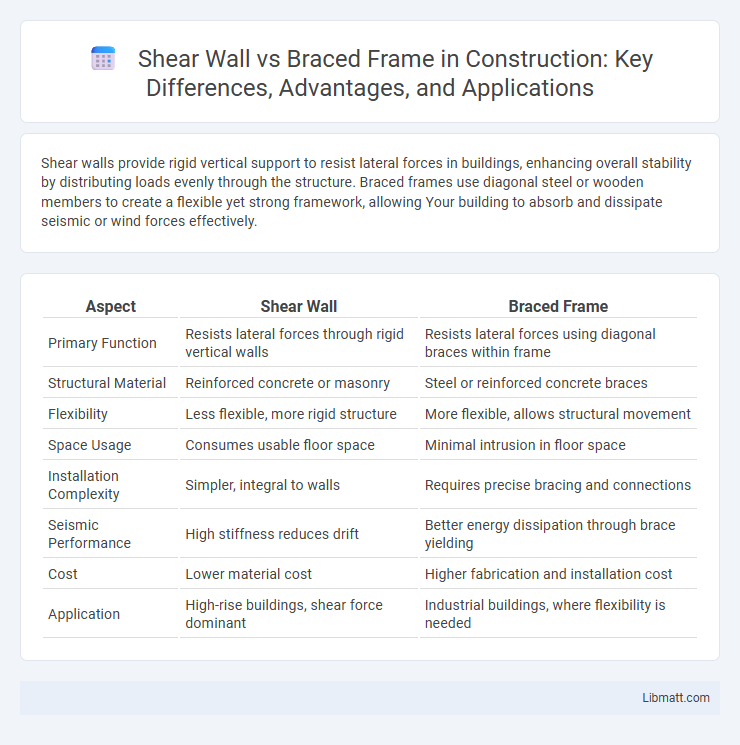Shear walls provide rigid vertical support to resist lateral forces in buildings, enhancing overall stability by distributing loads evenly through the structure. Braced frames use diagonal steel or wooden members to create a flexible yet strong framework, allowing Your building to absorb and dissipate seismic or wind forces effectively.
Table of Comparison
| Aspect | Shear Wall | Braced Frame |
|---|---|---|
| Primary Function | Resists lateral forces through rigid vertical walls | Resists lateral forces using diagonal braces within frame |
| Structural Material | Reinforced concrete or masonry | Steel or reinforced concrete braces |
| Flexibility | Less flexible, more rigid structure | More flexible, allows structural movement |
| Space Usage | Consumes usable floor space | Minimal intrusion in floor space |
| Installation Complexity | Simpler, integral to walls | Requires precise bracing and connections |
| Seismic Performance | High stiffness reduces drift | Better energy dissipation through brace yielding |
| Cost | Lower material cost | Higher fabrication and installation cost |
| Application | High-rise buildings, shear force dominant | Industrial buildings, where flexibility is needed |
Introduction to Shear Walls and Braced Frames
Shear walls are vertical structural elements designed to resist lateral forces caused by wind or seismic activity, providing stiffness and strength to a building's framework. Braced frames consist of diagonal steel or concrete braces that create a triangulated system, enhancing stability and distributing lateral loads efficiently. Both systems are crucial in earthquake-resistant design, with shear walls offering continuous resistance through walls and braced frames providing flexibility and ductility through framed connections.
Structural Function and Purpose
Shear walls provide lateral stiffness and strength by acting as continuous vertical panels that resist horizontal forces from wind and seismic activity, ensuring building stability. Braced frames use diagonal steel or wooden members to transfer lateral loads to the foundation, allowing flexibility while controlling building sway. Both systems enhance structural integrity, but shear walls typically offer more rigidity, whereas braced frames provide adaptable and economical resistance in various architectural designs.
Key Differences Between Shear Walls and Braced Frames
Shear walls and braced frames are critical structural elements designed to resist lateral forces such as wind and seismic loads. Shear walls are rigid vertical panels that provide high stiffness and strength by transferring lateral loads directly to the foundation, while braced frames utilize diagonal steel braces to create a triangulated system that dissipates energy through deformation. Your choice between shear walls and braced frames depends on factors like architectural flexibility, load resistance requirements, and construction costs.
Material Selection and Construction Methods
Shear walls are typically constructed using reinforced concrete or masonry, offering high stiffness and load-bearing capacity through continuous vertical surfaces, while braced frames use steel or timber with diagonal braces to resist lateral forces via tension and compression. Material selection for shear walls prioritizes mass and rigidity, making concrete optimal for tall structures; braced frames emphasize ductility and flexibility, favoring steel for rapid assembly and lightweight design. Construction methods for shear walls involve formwork, pouring, and curing processes, often leading to longer installation times, whereas braced frames utilize prefabricated steel components that enable faster erection and easier modifications on-site.
Seismic Performance Comparison
Shear walls provide superior lateral stiffness and energy dissipation, making them highly effective in resisting seismic forces in both low- and high-rise buildings. Braced frames offer flexibility and allow more architectural freedom but may exhibit less damping capacity compared to shear walls under seismic loading. Structural engineers prefer shear walls in high-seismic zones for enhanced rigidity, while braced frames are advantageous for moderate seismic regions requiring faster construction.
Design Considerations and Flexibility
Shear walls provide high lateral stiffness and strength, making them ideal for resisting seismic and wind forces in tall buildings, but they can limit architectural flexibility due to their continuous vertical placement. Braced frames offer greater design versatility and allow for open floor plans, as braces can be strategically positioned without obstructing space. Your choice depends on balancing the need for structural rigidity with the desired architectural layout and functional adaptability.
Cost Analysis and Economic Factors
Shear walls generally offer a more cost-effective solution for lateral load resistance in buildings due to their simpler construction and reduced material requirements compared to braced frames. Braced frames often involve higher fabrication and installation costs driven by steel components and complex connections, which can increase overall project expenses. Your choice between shear wall and braced frame systems should consider long-term economic factors like maintenance, material availability, and construction speed to optimize budget efficiency.
Applications in Various Building Types
Shear walls are commonly applied in residential and high-rise buildings to provide robust lateral resistance against wind and seismic forces, ensuring structural stability. Braced frames are favored in commercial and industrial buildings due to their flexibility and ease of construction, allowing for larger open spaces without compromising strength. Your choice between shear wall and braced frame depends on the architectural requirements and the nature of lateral load demands in the specific building type.
Advantages and Disadvantages
Shear walls provide superior lateral stiffness and strength, making them highly effective in resisting seismic and wind forces, but they can limit architectural flexibility and increase construction costs. Braced frames offer greater design versatility and are generally lighter, allowing easier modifications and openings, though they may provide less overall stiffness and require additional maintenance. Your choice between shear walls and braced frames depends on the balance between structural performance demands and architectural requirements.
Conclusion: Choosing the Right System
Choosing the right lateral force-resisting system depends on factors such as building height, architectural requirements, and seismic risk. Shear walls provide superior stiffness and strength for high-rise buildings, while braced frames offer greater flexibility and ease of installation in irregular layouts. Your structural design must balance these considerations to ensure optimal performance and cost-efficiency.
Shear wall vs braced frame Infographic

 libmatt.com
libmatt.com